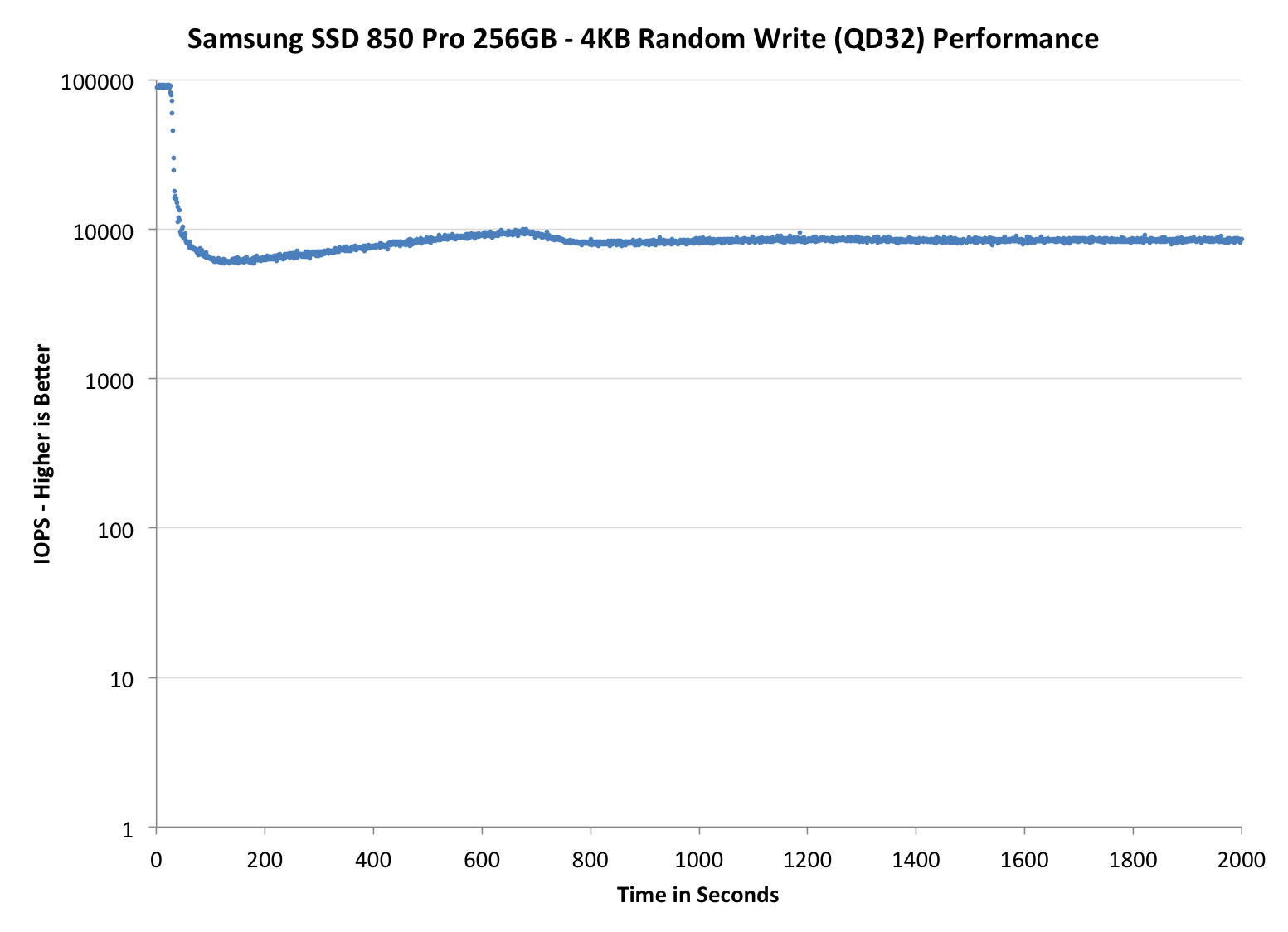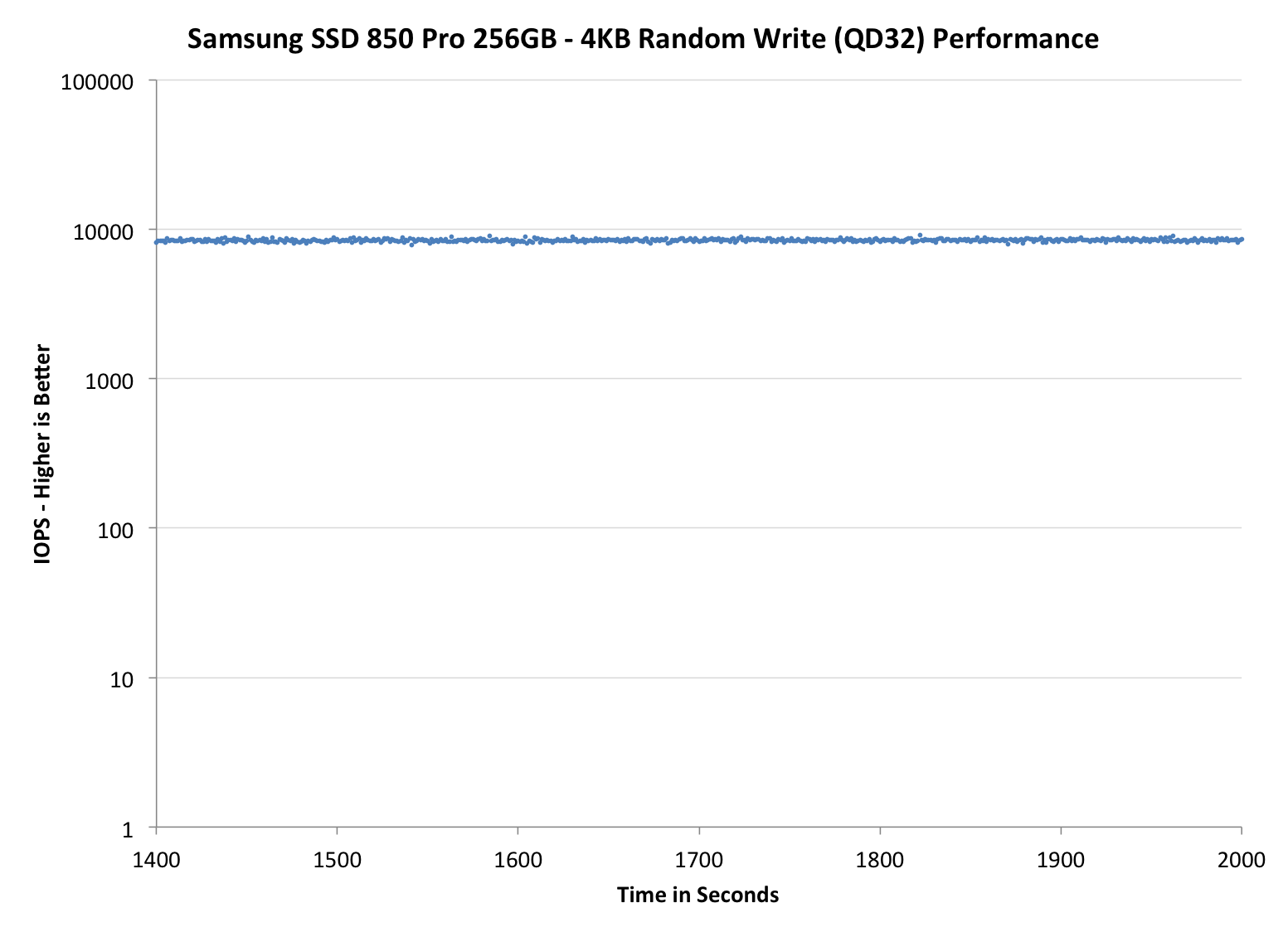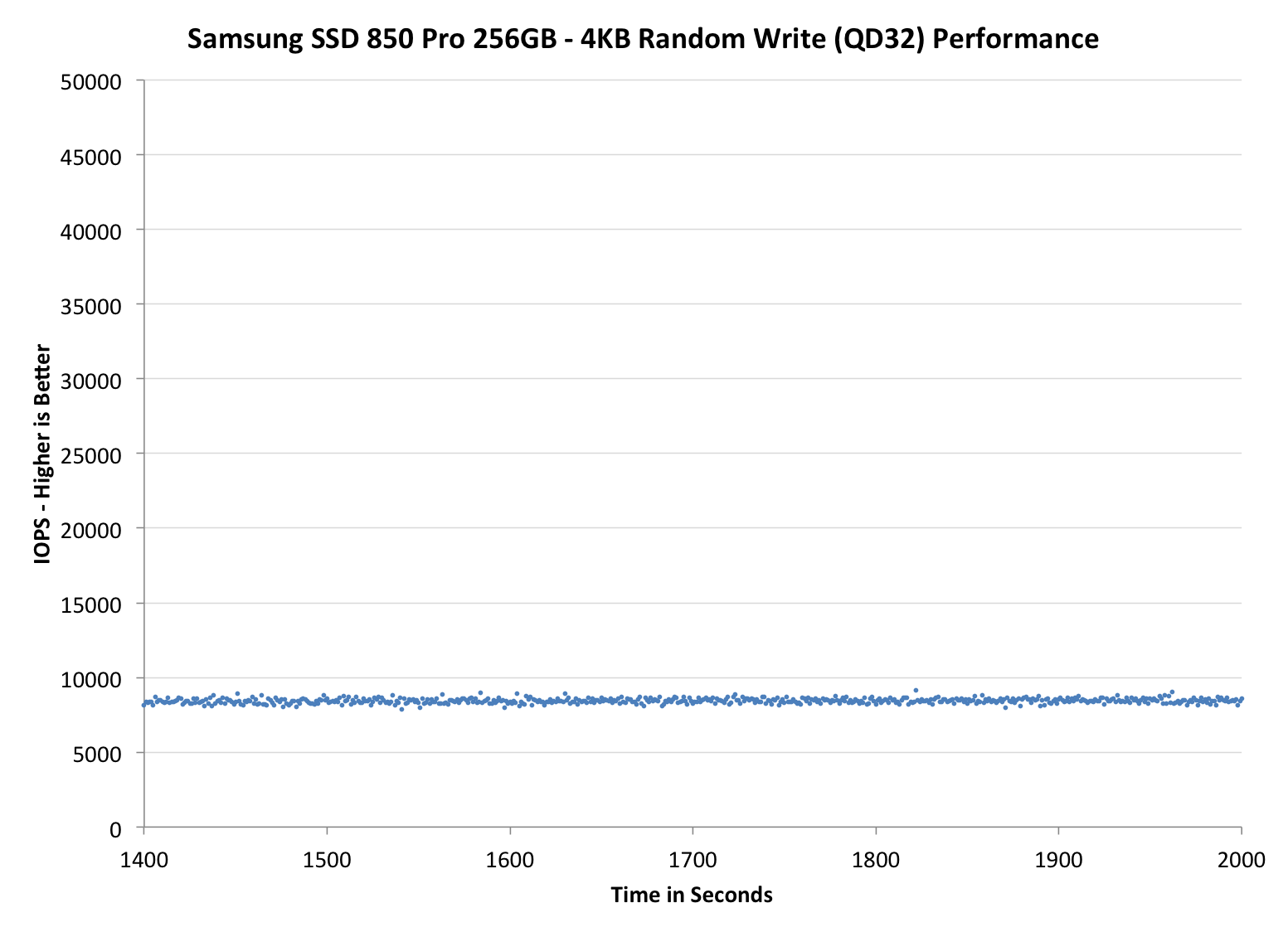Samsung SSD 850 Pro (128GB, 256GB & 1TB) Review: Enter the 3D Era
by Kristian Vättö on July 1, 2014 10:00 AM ESTPerformance Consistency
Performance consistency tells us a lot about the architecture of these SSDs and how they handle internal defragmentation. The reason we don’t have consistent IO latency with SSD is because inevitably all controllers have to do some amount of defragmentation or garbage collection in order to continue operating at high speeds. When and how an SSD decides to run its defrag or cleanup routines directly impacts the user experience as inconsistent performance results in application slowdowns.
To test IO consistency, we fill a secure erased SSD with sequential data to ensure that all user accessible LBAs have data associated with them. Next we kick off a 4KB random write workload across all LBAs at a queue depth of 32 using incompressible data. The test is run for just over half an hour and we record instantaneous IOPS every second.
We are also testing drives with added over-provisioning by limiting the LBA range. This gives us a look into the drive’s behavior with varying levels of empty space, which is frankly a more realistic approach for client workloads.
Each of the three graphs has its own purpose. The first one is of the whole duration of the test in log scale. The second and third one zoom into the beginning of steady-state operation (t=1400s) but on different scales: the second one uses log scale for easy comparison whereas the third one uses linear scale for better visualization of differences between drives. Click the buttons below each graph to switch the source data.
For more detailed description of the test and why performance consistency matters, read our original Intel SSD DC S3700 article.
 |
|||||||||
| Samsung SSD 850 Pro | Samsung SSD 840 Pro | SanDisk Extreme Pro | Intel SSD 730 | OCZ Vector 150 | |||||
| 7% Over-Provisioning | - | - | - | ||||||
| 12% Over-Provisioning | |||||||||
| 25% Over-Provisioning | |||||||||
Wow, this is awesome. Even with the default 7% over-provisioning, the 850 Pro is pushing almost as many IOPS as the Extreme Pro with its 12% over-provisioning. When the over-provisioning is increased to the same 12% level, the 850 Pro is a leader without a doubt. Only the Vector 150 can come close, although it is nowhere hear as constant as the IOPS is ranging between 10K and 30K, whereas the 850 Pro can maintain a steady line.
When compared with the 840 Pro, the upgrade is tremendous. IO consistency was always the weak point of the 840 Pro, so it is great to see that Samsung has paid a great effort to fix that in the 850 Pro. A part of the performance increase obviously comes from the usage of V-NAND because with shorter program and erase latencies, the steady-state performance increases as the garbage collection takes less time and there are more empty blocks available.
Some of you may wonder the odd capacities at 25% over-provisioning but the reason is that I noticed an error in the old ones. Basically, the old 25% numbers were in gibibytes (i.e. 1024^3 bytes) whereas the other capacities have always been in gigabytes (1000^3 bytes). I decided to unify the capacities and now they are all reported in gigabytes. The actual testing or over-provisioning levels have not changes -- it is simply a matter of how the capacities are represented.
 |
|||||||||
| Samsung SSD 850 Pro | Samsung SSD 840 Pro | SanDisk Extreme Pro | Intel SSD 730 | OCZ Vector 150 | |||||
| 7% Over-Provisioning | - | - | - | ||||||
| 12% Over-Provisioning | |||||||||
| 25% Over-Provisioning | |||||||||
 |
|||||||||
| Samsung SSD 850 Pro | Samsung SSD 840 Pro | SanDisk Extreme Pro | Intel SSD 730 | OCZ Vector 150 | |||||
| 7% Over-Provisioning | - | - | - | ||||||
| 12% Over-Provisioning | |||||||||
| 25% Over-Provisioning | |||||||||










160 Comments
View All Comments
Cerb - Tuesday, July 1, 2014 - link
As soon as it is cheap enough. But, don't get your hopes up about performance. SD cards are mostly limited by the controllers being slow, and in the tiny package they fit in, with the narrow margins they have, there's not a lot of room, physically and economically, to give them fast controllers, even if you get a big one that must have several NAND dies, and are talking about full-size SD, where multiple channels might be viable. It sucks, and I dislike shopping for SD cards as much as anybody, but today, that's how it is.frenchy_2001 - Tuesday, July 1, 2014 - link
I think he was talking about V-NAND (3D cells) which is independent of the controller.I would guess it will, as density will continue to scale up which will make it the cheaper technology.
It is cutting edge now, but will let Samsung scale higher densities very aggressively in the coming years, replacing all their 2D NAND production (they announced it when presenting the 3D cells).
Harry Lloyd - Tuesday, July 1, 2014 - link
Personally I have no interest in this kind of performance, and I really hope they focus on reducing prices and increasing capacities. The MX100 is just great for home usage (system and gaming), and I would like to see a 512 GB equivalent for around 100 $ by the end of 2015.Spatty - Tuesday, July 1, 2014 - link
"Oftentimes when cell size is discussed, it is only the actual size of the cell that is taken into account, which leaves the distance between cells out of the conclusion."Incorrect. Oftentimes what is being discussed is the half pitch. The 16nm, 19nm, 20nm, etc of the die. That is not the cell. The cell is Always defined as the repeatable structure in a memory device, and this includes the space between cells as described. The cell size is incorrectly referenced as being the half pitch.
Then there is marketing gimmick by companies who call their products 19nm when it is really 19nm by 2xnm. A rectangle and not a true 19nm square half pitch.
Larry Endomorph - Tuesday, July 1, 2014 - link
Good review. Bad charts. All of these are useless to color blind people:http://images.anandtech.com/doci/8216/NAND%20overv...
http://images.anandtech.com/doci/8216/cell%20inter...
http://images.anandtech.com/doci/8216/V-NAND_1.png
http://images.anandtech.com/doci/8216/850%20Pro%20...
http://images.anandtech.com/doci/8216/850%20Pro%20...
http://images.anandtech.com/doci/8216/850%20Pro%20...
http://images.anandtech.com/doci/8216/850%20Pro%20...
http://images.anandtech.com/doci/8216/850%20Pro%20...
http://images.anandtech.com/doci/8216/850%20Pro%20...
http://images.anandtech.com/doci/8216/850%20Pro%20...
http://images.anandtech.com/doci/8216/850%20Pro%20...
Cerb - Tuesday, July 1, 2014 - link
I never paid much attention, but you're right. If they changed the point shapes, and maybe dashed a couple of the lines, they could take care of that easily.fokka - Tuesday, July 1, 2014 - link
it's great to see a new drive from samsung and even greater seeing them advancing ssd tech and performance in such substantial ways. keeping that in mind i'm not really surprised about the msrp sammy is asking for its drives. and as always when new devices hit the scene, we're comparing msrp with real market prices here, so the difference should be a bit lower in a couple weeks when enough stock is available.that said, even if sata3 remains the most important storage interface today, it's kind of a shame seeing such a beautiful drive limited by this "old" interface. i know the new standards like m2, sata3.2 and pci-e-drives are still kind of a mess, but we already saw what higher throughputs in combination with more efficient interface protocols can do and seeing an expensive enthusiast drive like the 850 pro connected to sata3 just makes it seem more limited than it needed to be.
all that said, it doesn't change much for the average user, or advanced users even, since for most people a good sized evo or crucial is all they ever need in the years to come. upgrading to expensive drives like the 850 will only make sense for the most demanding users, for the rest it will only get interesting again when pci based storage gets more affordable.
Daniel Egger - Tuesday, July 1, 2014 - link
Minor nit: There's no such thing as "pentalobe torx" it's either one or the other but I'm guessing that it might have been torx security since pentalobe screws have only been used by Apple a couple of years back.iwod - Tuesday, July 1, 2014 - link
Its great to see its doing well in power consumption area. Which is important in Notebook. I hope we could bring this down to 2W or even 1.5W during operation.I really do think our SSD storage tier deserve a PCI-E lane direct from CPU. It would be great if the market just settle on 2x PCI-E 3.0 from CPU. We get 2GB/s out of it. That is plenty of headroom to grow until we move to PCI-E 4.0
hojnikb - Tuesday, July 1, 2014 - link
Thats what sata-express is doing